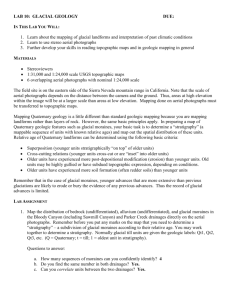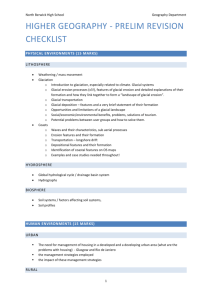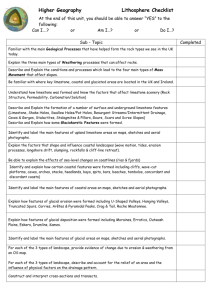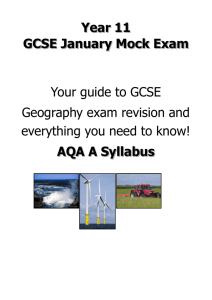LAB 1: MINERAL IDENTIFICATION
advertisement
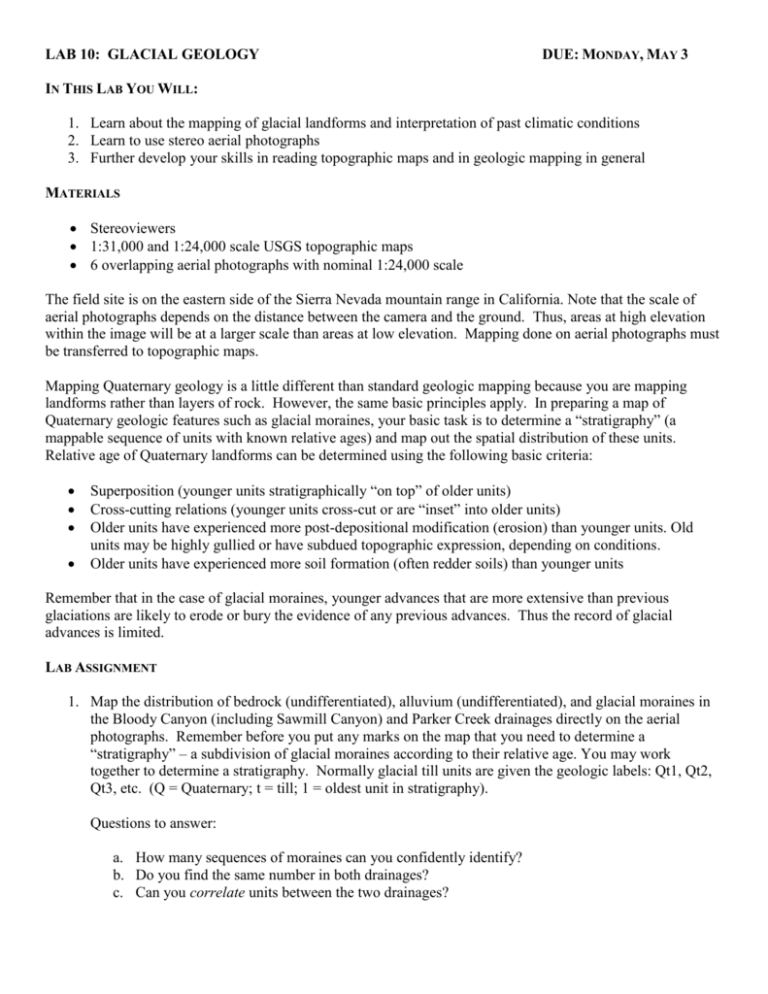
LAB 10: GLACIAL GEOLOGY DUE: MONDAY, MAY 3 IN THIS LAB YOU WILL: 1. Learn about the mapping of glacial landforms and interpretation of past climatic conditions 2. Learn to use stereo aerial photographs 3. Further develop your skills in reading topographic maps and in geologic mapping in general MATERIALS Stereoviewers 1:31,000 and 1:24,000 scale USGS topographic maps 6 overlapping aerial photographs with nominal 1:24,000 scale The field site is on the eastern side of the Sierra Nevada mountain range in California. Note that the scale of aerial photographs depends on the distance between the camera and the ground. Thus, areas at high elevation within the image will be at a larger scale than areas at low elevation. Mapping done on aerial photographs must be transferred to topographic maps. Mapping Quaternary geology is a little different than standard geologic mapping because you are mapping landforms rather than layers of rock. However, the same basic principles apply. In preparing a map of Quaternary geologic features such as glacial moraines, your basic task is to determine a “stratigraphy” (a mappable sequence of units with known relative ages) and map out the spatial distribution of these units. Relative age of Quaternary landforms can be determined using the following basic criteria: Superposition (younger units stratigraphically “on top” of older units) Cross-cutting relations (younger units cross-cut or are “inset” into older units) Older units have experienced more post-depositional modification (erosion) than younger units. Old units may be highly gullied or have subdued topographic expression, depending on conditions. Older units have experienced more soil formation (often redder soils) than younger units Remember that in the case of glacial moraines, younger advances that are more extensive than previous glaciations are likely to erode or bury the evidence of any previous advances. Thus the record of glacial advances is limited. LAB ASSIGNMENT 1. Map the distribution of bedrock (undifferentiated), alluvium (undifferentiated), and glacial moraines in the Bloody Canyon (including Sawmill Canyon) and Parker Creek drainages directly on the aerial photographs. Remember before you put any marks on the map that you need to determine a “stratigraphy” – a subdivision of glacial moraines according to their relative age. You may work together to determine a stratigraphy. Normally glacial till units are given the geologic labels: Qt1, Qt2, Qt3, etc. (Q = Quaternary; t = till; 1 = oldest unit in stratigraphy). Questions to answer: a. How many sequences of moraines can you confidently identify? b. Do you find the same number in both drainages? c. Can you correlate units between the two drainages? Once you have established your stratigraphy, map the distribution of each moraine on the aerial photos (color pencils may not work, so mark unit contacts and label units carefully and clearly in ink). Also map in the surrounding bedrock and alluvium (no need to subdivide these units for this mapping effort). 2. Transfer your aerial photographic mapping to the 1:31,000 scale base map. You may find that you will need to look at the 1:24,000 scale maps (same approximate scale as the aerial photos and with more detail than the base map) to figure out exactly where different features you mapped on the photos are on the base map. 3. Map out the approximate extent of glacial ice during the last glacial advance. To do this, use the topographic maps to pick out the approximate position of the glacier trim line (the highest elevation along the valley wall that was scoured by the glacier). This should be marked by a combination of a steep cliff face, a smooth, U-shaped valley below, and gentler, rougher valley walls above. In the cirques, modern snowfields often given an approximate indication of the minimum level of ice occupation. This mapping should be completed for both drainages on the 1:31,000 scale base map. Again, you may find the detail available on the 1:24,000 scale maps useful. 4. Estimate the paleo “equilibrium line altitude” (ELA, the mass balance position on a glacier discussed in class) using the following approximate methods: a. The highest elevation in moraines associated with the full glacial advance b. The lowest cirque basin c. The elevation halfway between the terminal moraine crest and the top of the ice at the headwall of the highest cirque Questions to answer: d. How consistent are these methods? e. If the modern ELA in this area is approximately 3800m, how much ELA depression occurred during the last glacial advance? f. How does this compare to the ~800 – 1000m figure estimated elsewhere? TURN IN Inked aerial photographic maps Inked 1:31,000 scale base map Answers to all the questions posed above 2
